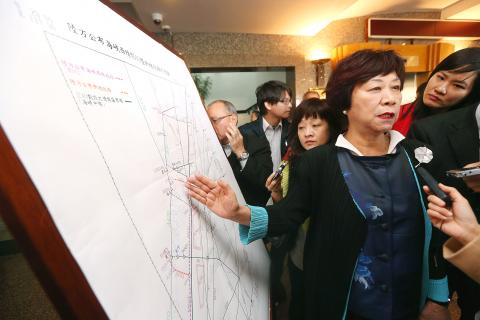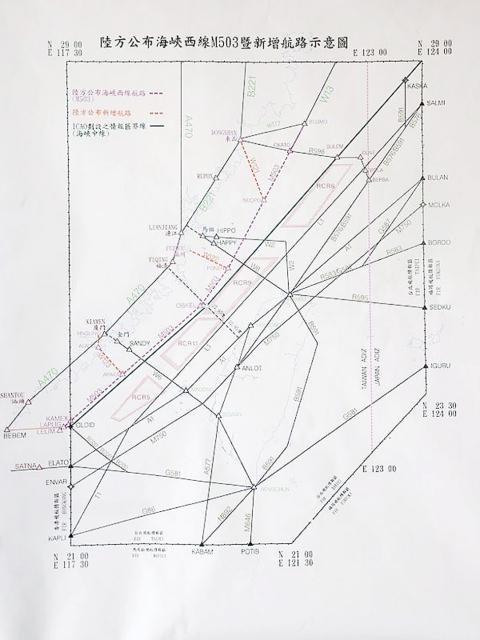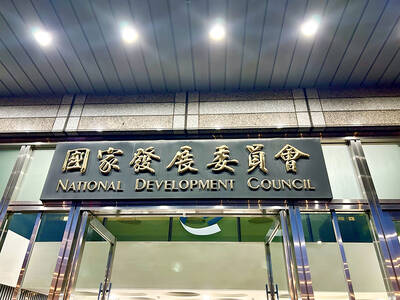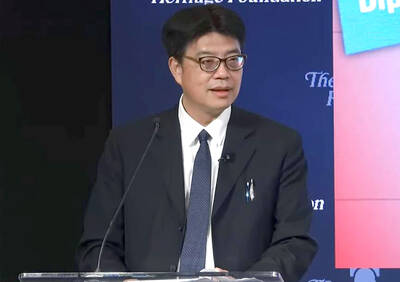A unilateral decision by China to establish new aviation routes near the midline of the Taiwan Strait without further negotiations with Taipei was “unacceptable,” the Civil Aeronautics Administration (CAA) said yesterday, adding that it would seek to communicate with the Chinese government on related safety issues in the months to come.
CAA Director-General Jean Shen (沈啟) said that Beijing announced an updated aviation safety bulletin on Monday morning which included four new air routes near China’s southeast coast. Among them, a route labeled M503 is nearly parallel to the middle line of the Taiwan Strait, coming as close to the line as 7.8km.
Additionally, three more routes — W121, W122 and W123 — were established as feeder routes for M503, she said.

Photo: CNA
“The air route W122 would affect Taiwanese air routes W8 and W2, which are used by Taiwanese flights to the outlying islands of Matsu,” Shen said. “The W123 route, on the other hand, is close to Taiwanese route W6, which is used by flights to Kinmen.”
Shen said that Beijing intended to use the M503 route to ease the load on its southeast coast route, which connects Shanghai, Fuzhou, Xiamen, Shenzhen, Zhuhai, Guanzhou and Hong Kong.
She said that both sides had had only “informal discussions” about creating such a route, including addressing the potential deviation of air routes due to inclement weather conditions, air traffic control issues and adjusted aircraft altitudes.

Photo courtesy of the Civil Aeronautics Administration
However, the two sides have not reached consensus on any one of these issues, she said.
The three feeder routes further surprised the administration, as Beijing had not mentioned anything about them previously, she said.
“Based on the spirit of the international civil aviation agreement, any member of the International Civil Aviation Organization should engage in negotiations in advance if any of its new air routes would affect the flight information regions [FIR] nearby,” Shen said. “We find China’s unilateral decision to establish these routes unacceptable. China should continue its communication with us, following the spirit of the international civil aviation agreement.”
Shen said China is scheduled to start using these routes at midnight on March 5, adding that it had indicated that the flights would operate along a buffer zone that is about 7.4km west of M503 when the route goes into service.
However, she said that M503 falls within the Shanghai FIR, which is very close to the Taipei FIR and has to accommodate many international flights.
In light of potential aviation safety concerns that the new route could engender, Shen said the CAA would communicate the technical issues to China.
CAA air traffic control department director Lee Jian-kuo (李建國) said that determining how far west of M503 the CAA would want the routes to move requires further talks with China, adding that the agency wants the buffer zone to be “as large as possible.”
Also, the Ministry of National Defense said that military air patrols would not be changed by China’s flight route plans, adding that patrols of Taiwan’s airspace will be increased, if necessary.
The military conducts airborne patrols throughout the nation’s airspace and these will not be affected by China’s route proposals, the ministry said in a statement.
Questioned about national security concerns, the ministry said that it will continue to monitor aircraft near the median line of the Taiwan Strait and increase air patrols if necessary.
In accordance with the principles of “No fear, no evasion and no showing of weakness,” the ministry said it would monitor, intercept or expel aircraft entering Taiwanese airspace without prior notification.

Taiwan is projected to lose a working-age population of about 6.67 million people in two waves of retirement in the coming years, as the nation confronts accelerating demographic decline and a shortage of younger workers to take their place, the Ministry of the Interior said. Taiwan experienced its largest baby boom between 1958 and 1966, when the population grew by 3.78 million, followed by a second surge of 2.89 million between 1976 and 1982, ministry data showed. In 2023, the first of those baby boom generations — those born in the late 1950s and early 1960s — began to enter retirement, triggering

ECONOMIC BOOST: Should the more than 23 million people eligible for the NT$10,000 handouts spend them the same way as in 2023, GDP could rise 0.5 percent, an official said Universal cash handouts of NT$10,000 (US$330) are to be disbursed late next month at the earliest — including to permanent residents and foreign residents married to Taiwanese — pending legislative approval, the Ministry of Finance said yesterday. The Executive Yuan yesterday approved the Special Act for Strengthening Economic, Social and National Security Resilience in Response to International Circumstances (因應國際情勢強化經濟社會及民生國安韌性特別條例). The NT$550 billion special budget includes NT$236 billion for the cash handouts, plus an additional NT$20 billion set aside as reserve funds, expected to be used to support industries. Handouts might begin one month after the bill is promulgated and would be completed within

The National Development Council (NDC) yesterday unveiled details of new regulations that ease restrictions on foreigners working or living in Taiwan, as part of a bid to attract skilled workers from abroad. The regulations, which could go into effect in the first quarter of next year, stem from amendments to the Act for the Recruitment and Employment of Foreign Professionals (外國專業人才延攬及僱用法) passed by lawmakers on Aug. 29. Students categorized as “overseas compatriots” would be allowed to stay and work in Taiwan in the two years after their graduation without obtaining additional permits, doing away with the evaluation process that is currently required,

IMPORTANT BACKER: China seeks to expel US influence from the Indo-Pacific region and supplant Washington as the global leader, MAC Minister Chiu Chui-cheng said China is preparing for war to seize Taiwan, Mainland Affairs Council (MAC) Minister Chiu Chui-cheng (邱垂正) said in Washington on Friday, warning that Taiwan’s fall would trigger a regional “domino effect” endangering US security. In a speech titled “Maintaining the Peaceful and Stable Status Quo Across the Taiwan Strait is in Line with the Shared Interests of Taiwan and the United States,” Chiu said Taiwan’s strategic importance is “closely tied” to US interests. Geopolitically, Taiwan sits in a “core position” in the first island chain — an arc stretching from Japan, through Taiwan and the Philippines, to Borneo, which is shared by